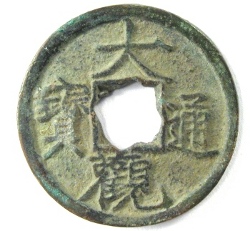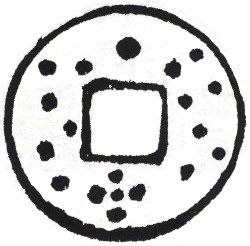
The “da guan tong bao” (大觀通寶) coin shown here was cast during the years 1107-1110 of the reign of Emperor Hui Zong of the Song Dynasty. The coin is considered one of the most beautiful of all Chinese coins due to its exquisite calligraphy. The Emperor himself did the calligraphy and his style has become known as “slender gold” script (shou jin shu 瘦金書).
The “da” (大) in the inscription means “great” and “guan” (觀) means “to behold” or “to gaze upon”.
Stars and star constellations were important to the ancient Chinese as sources of “light” and as symbols of deities and their residences.
“Guan” (觀) was also the word used for “gazing” at the stars and is found in such expressions as “guan tian wen” (觀天文) and “guan xing dou” (觀星斗) which mean to practice astronomy or astrology.
Even more interesting, the word “guan” (觀) can mean a Daoist monastery. Emperor Hui Zong was himself an ardent Daoist and openly promoted religious Daoism (Taoism) during his reign.
So, it is not surprising that the ancient Chinese would want to create charms with “star” themes based on the “da guan tong bao” coin.

At the left is a rubbing of the reverse side of such a “star” charm. The obverse side of the charm looks exactly like the “da guan tong bao” coin shown above.
The large dot or “star” at the very top represents the North Star (bei ji xing 北極星). The Chinese refer to this star as the “taiji” (太極) or “supreme ridgepole” and it was considered to be the central point from which the fabric of the heavens was suspended and around which all other heavenly bodies rotated.
To the right of the square hole is a series of seven dots or “stars” representing the “Northern Bushel” (beidou 北斗), “Ladle” or “Big Dipper”. The ancient Chinese saw this as the Emperor’s chariot which would rotate around the fixed North Star.
There are six dots or “stars” at the left of the square hole. If the dots were connected, the resulting line would resemble a “w” or “m” turned on its side. The Chinese refer to this “six star” constellation as xian hou zuo (仙后座) which is known in the West as the “five star” constellation “Cassiopeia”.
The “Big Dipper” and “Cassiopeia” are the two most prominent star patterns in the northern sky. They are always on opposite sides of the North Star, as shown on this charm, and rotate around the polar star once each day.
The Chinese call the five “star” cluster located below the square hole the tian qin xing zuo (天琴星座) which is known in the West as the constellation Lyra. The star at the top of the constellation is the “Girl Weaver Star” (zhi nu xing 織女星) which is the star Vega.
For more about the story of the “Weaver Girl”, and Chinese astronomy in general, please see Chinese Astronomy Coins.
Nice writing
Hello. I collect ancient coins with astronomical symbolism. In your website you show a Chinese coin with constellations and the Milky Way. Do you have any suggestions where I can find such a coin to purchase? As far as I know it is one of the few ancient coins I have found depicting the constellations. I am interested in any other Chinese coins with visual astronomical symbolism. Thank you.
-Charles